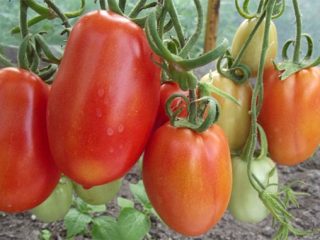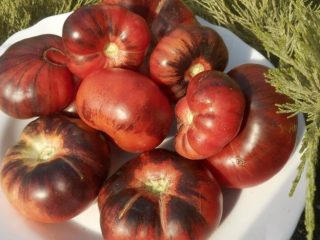Content
Among the huge variety of tomato varieties, beginning gardeners are often guided by the attractive appearance of tomatoes in the picture of the package, or by the unusual name of the variety. In this sense, the name of the tomato, Paradise Delight, does not speak, but simply screams about the need to taste its fruits and enjoy its “heavenly” taste. However, if we remove a certain amount of exaggeration, we can say that the originators of this variety were not far from the truth - many people really enjoy the taste of these tomatoes. What other characteristics does the Paradise Delight tomato have, and what interesting things can be found in the description of this variety?
History of occurrence and description of the variety
In the distant 90s of the last century, scientists and breeders of the Pridnestrovian Research Institute of Agriculture obtained a new variety, which received the enthusiastic name “Paradise Delight”. In 1997, the variety was officially registered in the State Register of Russia, and this time the Moscow company Aelita was the originator.
Tomato plants "Paradise Delight" are indeterminate, that is, they are not limited in growth and development and therefore require mandatory pruning and pinching in order to get ripe fruits. The bushes themselves are quite powerful, characterized by an abundance of large dark green leaves that can protect flowers and fruits during ripening from overly intense solar radiation in southern latitudes.
In greenhouse conditions they can reach two meters, but in open ground they rarely grow above 1.5-1.6 meters. The inflorescences are simple.
If you look at the ripening period, the Paradise Delight tomato is more likely to be a mid-season variety. The first ripe tomatoes can be detected after 120-127 days from the appearance of mass shoots.
According to gardeners, the yield of this variety greatly depends on the conditions of growth and care.
But sometimes it can reach 4-5 kg per plant. In this case, from 1 sq. meter you can get up to 9-10 kg of tomatoes.
One of the advantages of the Paradise Delight variety is its good resistance to nightshade diseases. It is practically not affected by tobacco mosaic virus, cladosporiosis and bacterial spot. Characterized by relative resistance to Alternaria. But it may suffer from late blight, so preventive work is required.
Tomatoes and their characteristics
The Paradise Delight tomato can rightfully be proud of its fruits, which are of the salad type, although the juice from them is also excellent.
- The shape of tomatoes is quite standard - round, slightly flattened, with lush folds near the stalk.
- Unripe fruits have a green color; near the stalk you can see a dark green spot, which disappears as the fruit ripens and the tomatoes turn red.
- The Paradise Delight variety can be classified as a large-fruited tomato - the average fruit weight is 400-450 grams. With good and proper care, the weight of one tomato can reach 700-800 grams.
- Tomatoes are distinguished by fleshy, juicy pulp, the number of seed chambers is more than four. But the seeds themselves are small and there are few of them. Contains dry matter from 5.5 to 6.2%.
- The skin is dense, the tomatoes are not prone to cracking and are stored quite well.
- The tomatoes have a high taste, however, it is difficult to expect anything else from a variety with such a promising name. The sugar content ranges from 3 to 3.6%, vitamin C – 17.3-18.2 mg. Acidity is approximately 0.5%.
Features of cultivation
Due to their rather late ripening period, tomatoes of this variety are recommended to be grown through seedlings even in the southern regions. It is advisable to sow seeds for seedlings in the beginning - the first half of March. If you have the opportunity to provide the seedlings with full lighting, then you can start sowing seeds even from the end of February. True, it makes sense to do this only if you have a greenhouse where you can plant seedlings in May and additionally protect them from possible return frosts.
Since the seedlings of the Paradise Delight variety look quite strong, with many large leaves, they require mandatory feeding even before planting in a permanent place of growth. It is best to use for these purposes a complex mineral fertilizer with microelements or vermicompost diluted in the required proportion.
Since the bushes are very powerful and require a garter, take care in advance of constructing a trellis or find the required number of tall stakes. It is necessary to plant Paradise Delight tomato plants with a frequency of no more than two or three plants per 1 square meter. meter.
To obtain maximum yields, tomato bushes should be grown in one or, at most, two stems. To form them into one stem, all absolutely stepchildren are preferably removed at the stage of their formation, so that they do not take away unnecessary strength from the bushes.
The remaining measures for caring for the Paradise Delight tomato are quite standard: regular watering, several feedings during the growth period, pruning and tying growing stems and preventive treatments against diseases and pests.
Reviews from gardeners
The Paradise Delight tomato has been known to gardeners for quite some time and has even passed the peak of its popularity, as new attractive varieties of tomatoes appear every year. Nevertheless, he still has his adherents and admirers who happily “taste the heavenly pleasure.”
Conclusion
Tomatoes Paradise Delight fully correspond to their name and deserve that you give them a little attention and care. And their resistance to disease makes them even more welcome guests on your site.














